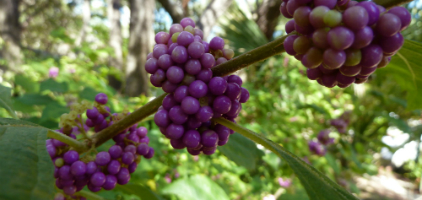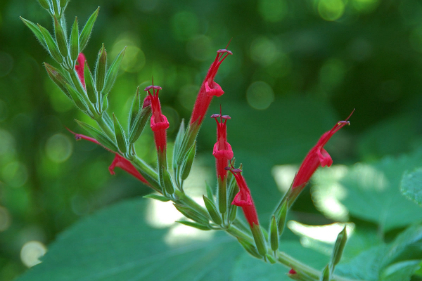
bringing nature, nurseries and gardeners together Sept 20, 2018
____________________________________________________
Nursery notes: Russ over at Wimberley Gardens reports that
they're well stocked for Halloween and fall, with plentiful amounts
of pumpkins and gourds. Mulch on sale: 3 bags for $10, and Happy
Frog soil conditioner, $28 (reg $30). At Brite Ideas on Saturday at
noon 'dive deep into composting and compost tea.' (Free lecture)
At The Natural Gardener on Saturday at 10 a.m. Linda Wall will
demonstrate the craft of Small Batch Canning .' At PEAS Farm
Day (also on Saturday) volunteers will gather to prepare a bed for
the teachers at Cunningham Elementary (2200 Berkeley Ave,
78745) to use with classes. 9 - 11 a.m. Full details: PEAS ❦

American Beautyberry Jelly: the astonishing magenta-colored
berries of Callicarpa americana that are in season now can be
turned into 'exceptionally good' jelly, writes Deane from Eat the
Weeds. Plus you can repel mosquitos with their leaves. Much to
celebrate about this shade-loving perennial. Eat The Weeds ❦
____________________________________________________
A letter from Joe Smith: 'My favorite bulbs are rain lilies. They
come in a lot of colors and the native ones are spectacular. A note
about Muscari, for Texas, I have had the best luck with Neglectum.
The others tend to burn out after a few years. I have also had great
luck with species gladioli, liatris, and the native (naturalized?) pink
oxalis.' Thanks Joe!❦
____________________________________________________
Seven fall spices you can grow at home: if you're looking to
grow 'the stuff that gives a real kick to chai, curry or goulash,'
then you should consider growing your own spices, writes Brian
Barth. Saffron, tumeric, coriander, cumin and fenugreek are all
possibilities. Modern Farmer ❦
____________________________________________________

The Austin Garden is sponsored by the.Hays Free Press

___________________________________________________
Central Texas Gardener: Yarrow Landscaping scopes out ideas
for privacy, living spaces, and floodwater control in small, con-
temporary gardens. On tour, a visit to the garden of designer
Diana Kirby. Also Tonya Peele from plant + shoot illustrates how
to frame garden pictures. See the show on Saturday 4 p.m., Sunday
9 a.m. KLRU ❦

'Tis the Season for Fall Perennials
by Chris Winslow
With the arrival of the fall equinox this weekend, we can hopefully
start looking forward to some cooler temperatures in the upcoming
weeks. We will then be entering a time of beautiful fall color from
a number of perennials that just seem to flourish and thrive in our
central Texas region.
Chrysanthemums for example - from the aster family - come in a
vast array of colors, are easy to grow, and return year after year.
Breaking dormancy in the spring, 'mums will grow to 2 x 2 feet
during the spring and summer and will set bud during the shorten-
ing days of fall. Some will show color by late September while
others bloom through October into November.
A sunny, well drained location with ample compost and slow rel-
ease organic fertilizer are needed for 'mums to excel. One of my
favorites is country girl. The combination of silvery foliage with
deep golden flowers is awesome.
Frikarti Asters (also known as 'monch asters') grow to the same
size as 'mums and have lavender-blue flowers. Grown under the
same conditions, they add their pretty color to our landscapes with-
out any fuss.
Both 'mums and asters also provide an opportunity for a welcome
late feeding for traveling butterflies and bees.
Another showy group is the genus Salvia. Mexican bush sage
(Salvia leucantha) puts on a huge display of purple and white flow-
ers on plants with silver like foliage with white stems.
Pineapple sage (Salvia rutilans) has deep scarlet flowers, and humm-
ingbirds love 'em! (see photo above)
There are two perennials in the marigold family that strut their stuff
in the fall. Mexican mint marigold (Tagetes lucida), also known as
Texas tarragon, produces small yellow flowers on anise-scented
foliage.
Copper Canyon daisy (Tagetes lemonii) displays larger daisy-like
flowers on some highly aromatic foliage. This plant blooms late
October through November.
Both of these perennial marigolds, along with the salvias, are deer-
proof.
American Beautyberry is another fun fall perennial to consider add-
ing to your garden. Found in the woods around Austin and through-
out east Texas, this deciduous native shrub blooms in the spring with
white flowers, followed in the fall with a display of clusters of start-
ling purple (and sometimes white) berries clinging to the branches.
Beautyberry loves shade to part sun and needs some supplemental
watering. The berries are popular with the birds and can disappear
before you know it.
Take a drive in the Hill Country as the days get cooler. Some of fall’s
colorful secrets can be found along the roadside. Happy gardening
everyone! ❦

